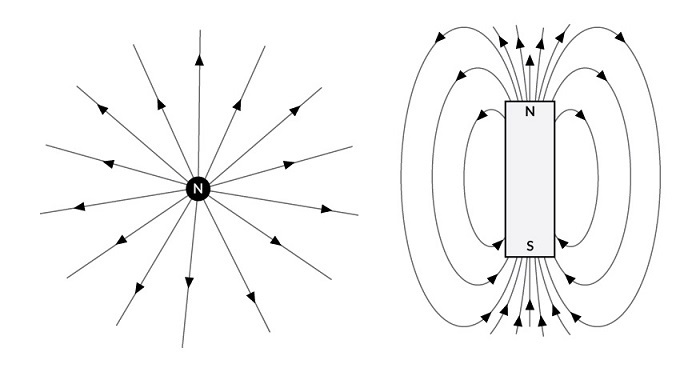|
Single-pole magnet emerges in frozen concoction

North Pole an artificial monopole(left), whose
manetic fields away in all directions, came from researchers' manipulation of an
ultracold gas. In a traditional bar magnet (right). the magnetic field and bends
toward the south pole.
Magazine issue:March 8, 2014
Somewhere lurking in the universe, most physicists agree, are minuscule magnets
with just one pole — a north or a south, but not both. Scientists haven’t
spotted any yet, but a new experiment offers an unprecedented glimpse at what
these elusive magnetic particles should look like.
“It provides a window into the physics of the particle without having the
particle itself in front of you,” says David Hall, the physicist at Amherst
College in Massachusetts who led the research.
Magnets seem to come in only one variety, with two poles like a bar magnet’s.
But in 1931, Nobel-prize winning physicist Paul Dirac demonstrated
mathematically that single-pole magnets, known as monopoles, could exist. His
mathematical reasoning was so strong that most physicists today have little
doubt of monopoles’ existence, despite decades of fruitless searches for them at
CERN and other leading institutions.
Hall had rarely thought about monopoles until 2009, when he read a paper that
proposed a way to simulate one in the lab. The recipe called for a Bose-Einstein
condensate, an exotic state of matter produced by cooling a gas to billionths of
a degree above absolute zero. At that extreme temperature, hundreds of thousands
of atoms can behave collectively like one particle, allowing scientists to
simulate quantum processes on a larger scale.
In following the recipe for an artificial monopole, Hall and his team had to
manipulate a condensate’s rubidium atoms, each of which acts like a compass
needle. The researchers exposed the atoms to a carefully crafted magnetic field,
which caused the compass needles to orient themselves toward a single point in
space — as if someone had placed an isolated north-pole magnet there. The researchers
detail their findings in the Jan.
30 Nature. “It’s a very nice
paper,” says Wolfgang Ketterle, an MIT physicist who shared the 2001 Nobel Prize
for demonstrating Bose-Einstein condensates.
Hall emphasizes that his creation is a simulation of a monopole: There is no
physical particle where the monopole appears to be. But he says the experiment
gives physicists a chance to explore a so-called quasiparticle that, at least
mathematically, behaves just as Dirac predicted an actual monopole would 83
years ago. “We’ve realized Dirac’s conception of what a magnetic monopole ought
to be, and his conception is the gold standard,” Hall says.
Hall expects other physicists to replicate his experiment and simulate how the
artificial monopole interacts with other particles. Such experiments could yield
clues as to how an actual magnetic monopole might reveal itself in nature.
ScienceNews

Contains: names, biographies and lectures
|


